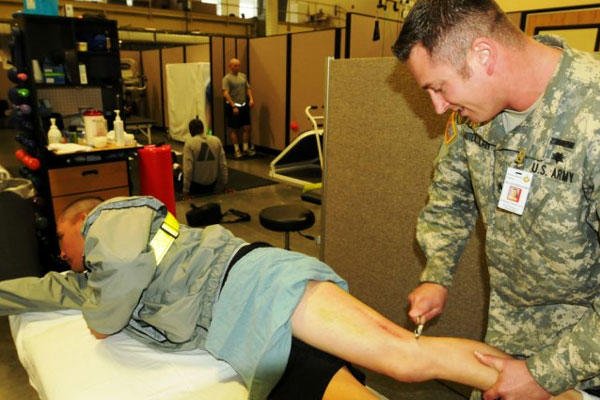The war may be winding down, but the Army continues to wage a campaign against something that grew increasingly apparent during the last decade of combat in Iraq and Afghanistan -- chronic pain among its troops.
"You can have people that have never been down range, that have done nothing but prepare to go downrange, that accumulate over a lifetime injuries, conditions … that may not have happened if we were a little more pro-active [in dealing with pain issues]," said Col. Kevin Galloway, Army Pain Management Director in the office of the Army Surgeon General.
Over the last 12 years, the military, the Army and Marine Corps in particular, found that the most common type of injury coming out of Afghanistan and Iraq was to a servicemember's musculoskeletal system. These have stemmed from combat wounds, stress and strains that go with carrying 80 to 100 pounds of gear over the rugged geography of those countries, or quickly dismounting with all that gear from a truck or Humvee.
Whatever the cause, the Army has been treating increasing numbers of soldiers for chronic pain over the years. What it and the DoD more broadly are trying to do now is find better ways to treat it, with less emphasis on painkillers.
Galloway, who is expected to make a presentation on the service's pain management program this week before the Association of the U.S. Army conference in Washington, said the Army's work in this area is seeing progress since the task force delivered its report in 2010.
He said recent data is still being confirmed, but it shows what had been a rise in the use of opiate medications for treating pain flattening and starting to come down, both in the number of unique servicemembers prescribed them and the length of time they're on them.
The Army stood up a Pain Management Task Force in 2009 to make recommendations to the Army Medical Command for a comprehensive approach to treating pain. The goal was to develop a strategy that is holistic, multi disciplinary and allows for multiple methods of treatment in order to provide injured troops an optimal quality of life.
The task force came up with 109 recommendations for improving and standardizing pain care in the Army. These included a coordinated focus on pain awareness, education and proactive intervention among medical staff, the patients and leadership and building a full spectrum of best practices for the continuum of acute and chronic pain care.
Based on the task force's work, the Army began incorporating into its pain management what has often been called alternative treatments such as yoga and massage. Galloway said he rejects the term "alternative," and said these are complementary treatments, part of a range of therapies for dealing with pain.
Another positive step in the area of pain management has been improved coordination with the Department of Veterans Affairs, which will take over a servicemember's care once he or she leaves the active duty.
According to a November 2012 GAO report more than 41,000 troops left the military while taking medication for pain during calendar years 2009 through 2011.
"On multiple lines of effort we've improved the DoD-VA collaboration," he said. In the area of pain, they struck a deal by which the VA would honor the active-duty military's prescription medication.
Previously, he said, the VA would prescribe only what they carried in its own formulary.
"They would start him on what they thought were equally affective medications. That caused some problems," he said.
The substitute meds did not always work for the veteran. Since the task force recommendations, however, "the VA said when they get these soldiers transitioning that the default is to fill [the prescription] what they had. That was a big improvement."




























